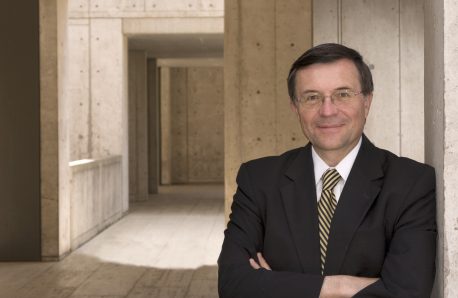
March 5, 2024
World’s largest neuroscience prize recognizes trio who pioneered field of computational and theoretical neuroscience and paved the way for brain-inspired artificial intelligence
World’s largest neuroscience prize recognizes trio who pioneered field of computational and theoretical neuroscience and paved the way for brain-inspired artificial intelligence
LA JOLLA—Salk Institute Professor Terrence Sejnowski will receive the 2024 Brain Prize for “pioneering the field of computational and theoretical neuroscience, making seminal contributions to our understanding of the brain, and paving the way for the development of brain-inspired artificial intelligence,” the Lundbeck Foundation announced today.

Sejnowski shares the prize—the world’s top recognition in neuroscience, totaling 10 million DKK (approximately $1.5 million)—with Larry Abbott of Columbia University and Haim Sompolinsky of Harvard University and Hebrew University. They will receive the award from His Royal Highness King Frederik of Denmark, at an event in Copenhagen on May 30, 2024.
“It is inconceivable to imagine modern brain sciences without the concomitant development of computational and theoretical neuroscience,” says Professor Richard Morris, chair of the Brain Prize Selection Committee. “These three scientists have applied novel and sophisticated approaches from physics, mathematics, and statistics to study the brain. They have developed vital tools for the analysis of highly complex datasets acquired by modern-day experimental neuroscientists.
“The three prize winners have also proposed conceptual frameworks for understanding some of the brain’s most fundamental processes, such as learning, memory, perception, and how the brain generates maps of the external world. They have also provided crucial new insights into what may go awry in several devastating disorders of the nervous system, such as epilepsy, Alzheimer’s disease, and schizophrenia. In addition, their scientific achievements have paved the way for the development of brain-inspired artificial intelligence, one of the emerging and transformational technologies of our time.”
Sejnowski, who is head of Salk’s Computational Neurobiology Laboratory, holder of the Francis Crick Chair, and a distinguished professor at UC San Diego, has helped shape the fields of neuroeconomics, neuroanatomy, neurophysiology, psychology, and artificial intelligence. In 1985, while at Johns Hopkins University, he collaborated with computer scientist Geoffrey Hinton to invent the Boltzmann machine, the first algorithm to solve the problem of learning in multilayered neural networks. It remains the most biologically plausible of all subsequent learning algorithms for artificial neural networks.
Soon after announcing the Boltzmann machine, Sejnowski created NETtalk, a computer program that, like the human brain, was able to learn how to turn written text into speech. Not only was this an astounding engineering accomplishment, but it also marked a major cultural milestone as it raised new challenges for philosophy, linguistics, and cognitive science.
Sejnowski also helped develop the first unsupervised learning algorithm for independent component analysis, which is now a mainstay in brain imaging. In addition, he has shown that sleep spindles (brain wave patterns during nonrapid eye movement sleep) are not synchronous across the cortex, as previously believed, but instead create circular traveling waves.
“Terry’s pioneering work in the field of neuroscience has long been recognized throughout the scientific community, and so this honor is not a complete surprise but is certainly an important accolade,” Salk President Gerald Joyce says. “His receiving the Brain Prize confirms how critical his work has been to our understanding of cognition and the world around us. We take special pride at Salk that two of our faculty have received this prize in the past three years, with Martyn Goulding having been honored in 2022.”
Sejnowski has received numerous other awards, including being named the 2024 Scientist of the Year by the ARCS Foundation of San Diego, winning the Gruber Prize in Neuroscience, the Institute of Electrical and Electronics Engineers Frank Rosenblatt Award, Neural Network Pioneer Award, Hebb Prize, and Wright Prize. He is a member of the National Academy of Sciences, National Academy of Medicine, National Academy of Engineering, and National Academy of Inventors.
“I am incredibly honored to receive the 2024 Brain Prize,” says Sejnowski. “I’m proud that this award recognizes the remarkable computational advances being made by computer scientists and neuroscientists to our understanding of brain function.”
About the Brain Prize:
The Brain Prize is the world’s largest neuroscience research prize, and it is awarded each year by the Lundbeck Foundation. The Brain Prize recognizes highly original and influential advances in any area of brain research, from basic neuroscience to applied clinical research. Recipients of The Brain Prize may be of any nationality and work in any country in the world. Since it was first awarded in 2011, The Brain Prize has been awarded to 47 scientists from 10 different countries. Brain Prize recipients are presented with their award by His Royal Highness King Frederik of Denmark, at a ceremony in the Danish capital, Copenhagen.
Office of Communications
Tel: (858) 453-4100
press@salk.edu
Unlocking the secrets of life itself is the driving force behind the Salk Institute. Our team of world-class, award-winning scientists pushes the boundaries of knowledge in areas such as neuroscience, cancer research, aging, immunobiology, plant biology, computational biology and more. Founded by Jonas Salk, developer of the first safe and effective polio vaccine, the Institute is an independent, nonprofit research organization and architectural landmark: small by choice, intimate by nature, and fearless in the face of any challenge.